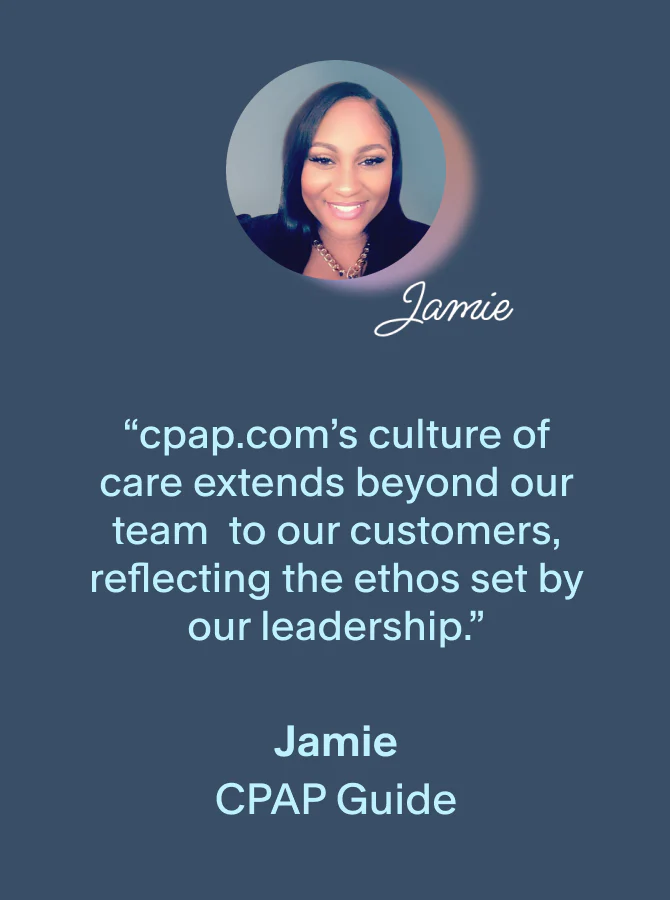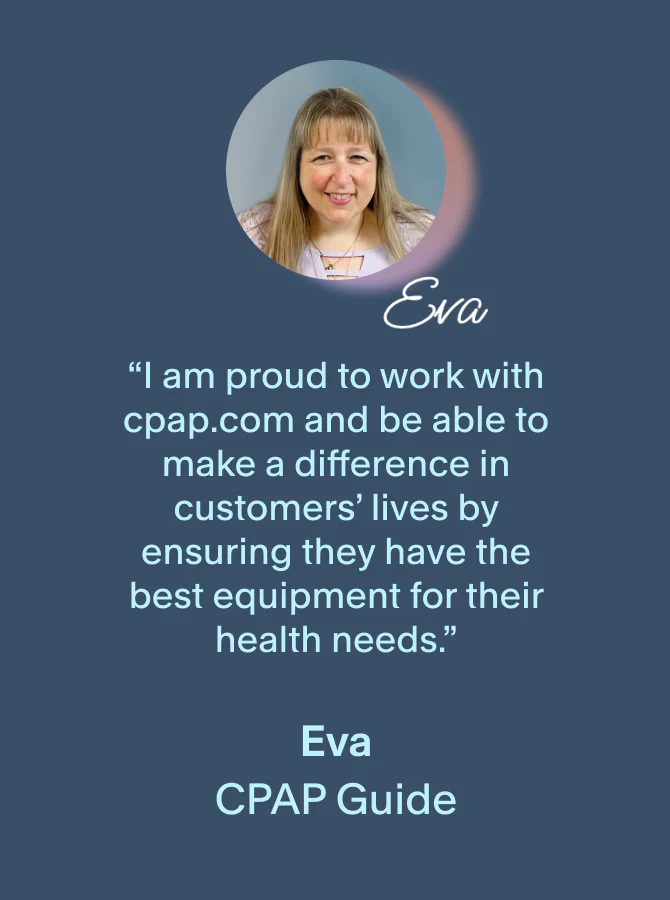Our content undergoes rigorous expert review, evidence-based research, and regular updates for accuracy.
Cleaning your CPAP the right way keeps you and your CPAP machine in tip-top shape! A good CPAP cleaning routine doesn’t just kill germs. It also removes built-up dirt and debris that can damage your equipment and impact the effectiveness of your CPAP therapy.
To keep your CPAP clean, you’ll need to focus on four specific areas– your CPAP mask, tubing, humidifier tank, and CPAP filter. That may sound like a lot, but we’re here to break it down with easy-to-follow instructions!
In this simple guide, we’ll cover:
- List of CPAP cleaning supplies you’ll need.
- CPAP cleaning schedule that works for you and your equipment.
- Step-by-step routine for cleaning your CPAP machine and mask.
- List of benefits of keeping your CPAP clean.
CPAP Cleaning Supplies You Need
Before you get started, there are a few CPAP cleaning supplies you’ll need for your equipment. We’ll go over what works and the best practices for cleaning that can help make your CPAP cleaning even easier.
| CPAP Mask Frame(Daily) | CPAP Mask Cushion(Daily) | CPAP Humidifier Chamber(Weekly) | CPAP Reusable Filters(Weekly) | CPAP Hose and Tubing(Weekly) | |
| Mild Soap | √ | √ | √ | √ | √ |
| Warm Water | √ | √ | √ | √ | √ |
| Distilled Cleaning Vinegar | √ | √ | √ | ||
| CPAP Wipes | √* | √* | √* | ||
| CPAP Sanitizing Machine | √* | √* | √* | √* | √* |
| CPAP Drying Machine | √* | √* | √* | √* | √* |
* Optional
The Basic Supplies to Clean Your CPAP
Keep in mind that keeping your CPAP clean doesn’t have to be hard or expensive. In fact, many people already have access to the basics in their own homes!
Technically, all you need is mild soap and warm water, but most experts also recommend cleaning your CPAP with mixed vinegar and water.
- Mild Soap: Stay away from harsh soaps, especially anti-bacterial soaps. The best soap to clean your CPAP is natural dish soap, baby shampoo, or special CPAP soap.
- Warm Water: When washing your CPAP equipment, be sure to use warm water to help kill germs. Make sure it isn’t too hot, or it can damage your cushion.
- Cleaning Vinegar: Diluted cleaning vinegar is very effective at killing germs. To dilute, mix 2 parts vinegar and 3 parts water. Do not wash your CPAP cushion or filter with vinegar.
- Soft Towel: It’s good to keep a microfiber towel around to help dry your equipment after each wash. You can also use a paper towel. Be very gentle when drying your cushion.
Nice-to-Have Supplies for CPAP Cleaning
Once you have the basics down, there are a lot of awesome CPAP accessories that make cleaning your CPAP so much easier.
- CPAP Wipes: Most manufacturers state that you can use CPAP wipes to clean your CPAP mask after each use. But, if you choose to do this, you will still need to wash all of your equipment every week.
- CPAP Cleaner: While mild household soaps do a good job, some people prefer to use soaps and cleaning solutions that are specifically made for CPAP machines, such as Snugell’s CPAP Wash.
- CPAP Disinfectant Solution: Instead of distilled cleaning vinegar, you can use a CPAP Control III Disinfectant, which is a CPAP cleaning solution that you can mix with water to target germs on your CPAP.
- CPAP Sanitizing Machine: The best CPAP sanitizers, such as the Liviliti Paptizer, use UV light to kill 99.9% of germs. But they don’t actually remove the dirt and debris on your equipment. While they cannot replace regular cleaning, they’re great for peace of mind.
- CPAP Dryers: It is safe to let your CPAP equipment air dry. However, if you forget to wash your equipment and want to do so before bed, a CPAP dryer can speed up your drying time to just a few minutes.
What to Avoid While Cleaning Your CPAP
When it comes to taking care of your CPAP equipment, there’s one rule that you must always keep in mind. Avoid harsh chemicals!
Cleaning your CPAP equipment with abrasive cleansers or chemicals will damage your equipment. It can also leave behind residue that can irritate your skin or even make you sick.
Do not use:
- Anti-Bacterial Soap
- Household Sanitizers
- Kitchen and Bathroom Cleaners
- Dishwashers
- Boiling Water
- Alcohol
How to Clean Your CPAP Equipment
https://www.youtube.com/watch?v=Jazfk7vbCJ4
Let’s go over how to clean the rest of your equipment– including your CPAP hose, water chamber, tube, and CPAP filter– during weekly cleanings! As a reminder, always check your CPAP mask and machine manual to be sure you are following all manufacturer instructions.
How to Clean Your CPAP Mask
Daily CPAP mask cleaning is pretty simple! After each use, wipe down or wash your cushion in mild soap and water before letting it air dry.
- Disassemble: Once a week, disassemble your mask by separating the headgear, mask cushion, nasal pillows, frame, and elbow.
- Wash: Gently wash your mask parts in mild soap and water.
- Soak: For a deep clean, soak your CPAP mask frame and elbow in a 2:3 vinegar water mix or CPAP disinfectant solution for 30 minutes or follow the instructions on the bottle.
- Rinse: Rinse your CPAP mask in warm water.
- Dry: Allow your CPAP equipment to fully dry before reassembling. Do not sit in direct sunlight.
- Sanitize: Place your CPAP mask parts in your CPAP cleaning machine to sanitize.
- Reassemble: Once your equipment is dry, you’re ready to reassemble all the parts so that your CPAP machine is ready to use again!
How to Clean Your CPAP Hose
Be sure to let your CPAP hose drain and air dry after each use.
- Disassemble: Once a week, disassemble your CPAP tube from your CPAP machine and mask.
- Wash: Gently wash your CPAP hose in mild soap and warm water.
- Scrub: Use a soft cloth to scrub each surface. You can use a CPAP tube cleaning brush to clean your tubing. Make sure there are no colored spots, which could be a sign of mold or bacteria.
- Soak: For a deep clean, soak your tube in a 2:3 vinegar water mix or CPAP disinfectant solution for 30 minutes or follow the instructions on the bottle.
- Rinse: Rinse your hose in warm water.
- Dry: Allow your CPAP equipment to fully dry before reassembling. Do not sit in direct sunlight. Be sure to hang your CPAP tube so it can fully drain and dry.
- Sanitize: Place your hose in your CPAP cleaning machine to sanitize.
- Reassemble: Once your equipment is dry, you’re ready to reassemble all the parts so that your CPAP machine is ready to use again!
How to Clean Your CPAP Water Chamber
After using your CPAP machine, be sure to empty and dry your CPAP humidifier each day.
- Disassemble: Once a week, disassemble your CPAP humidifier tank from your CPAP machine.
- Wash: Gently wash your water tank in mild soap and warm water.
- Scrub: Use a soft cloth to scrub each surface. You can use a CPAP tube cleaning brush to clean your tubing. Make sure there are no colored spots, which could be a sign of mold or bacteria.
- Soak: For a deep clean, soak your CPAP water tank in a 2:3 vinegar water mix or CPAP disinfectant solution for 30 minutes or follow the instructions on the bottle.
- Rinse: Rinse your water chamber in warm water.
- Dry: Allow your CPAP equipment to fully dry before reassembling. Do not sit in direct sunlight.
- Sanitize: Place your humidifier chamber in your CPAP cleaning machine to sanitize.
- Reassemble: Once your equipment is dry, you’re ready to reassemble all the parts so that your CPAP machine is ready to use again!
How to Clean Your CPAP Filter
Like your CPAP mask cushion, your CPAP filter should be washed gently and with care!
- Disassemble: Once a week, remove your CPAP filter from your CPAP machine.
- Wash: Gently wash your filter in mild soap and warm water.
- Rinse: Rinse your filter in warm water.
- Dry: Allow your filter to fully dry before reassembling. Do not sit in direct sunlight. Reassemble: Once your equipment is dry, you’re ready to reassemble all the parts so that your CPAP machine is ready to use again!
The Dos and Don’ts of Washing Your CPAP Machine and Mask
| Do | Don’t |
| Wash Your CPAP With Mild Soap | Use Harsh Chemicals or Anti-Bacterial Soaps |
| Use Warm Water | Use Boiling Water |
| Give Your CPAP Plenty of Time to Dry | Set It in Direct Sunlight to Dry |
| Use CPAP Wipes for Daily Cleaning | Only Use CPAP Wipes for Weekly Cleanings |
| Sanitize Your Equipment With a CPAP Cleaning Machine | Sanitize Your Equipment With Bleach |
| Let Your Hard Plastic CPAP Equipment Soak in Vinegar Each Week | Use Vinegar on Your CPAP Cushion or Filter |
| Unplug Your CPAP Before Cleaning It | Clean Your CPAP While Plugged In |
| Hang Your CPAP Hose and Mask Headgear to Dry | Dry Your CPAP Equipment in a Clothing Dryer |
CPAP Cleaning Schedule
Let’s take a look at how often you should clean your CPAP! Having to clean your CPAP mask every day may sound daunting. Just remember, you can use CPAP wipes on your mask and cushion each day, as long as you still wash them in soap and water at least once a week.
| CPAP Equipment | Amount of Necessary Cleaning |
| CPAP Mask Frame | Clean Daily With Wipes Wash Weekly With Soap and Water |
| CPAP Mask Cushion or Pillows | Clean Daily With Wipes Wash Weekly With Soap and Water |
| CPAP Headgear | Wash Weekly With Soap and Water |
| Humidifier Chamber | Empty and Dry Daily Wash Weekly With Soap and Water |
| CPAP Reusable Filters | Wash Weekly With Soap and Water |
| CPAP Hose | Hang to Dry Daily Wash Weekly With Soap and Water |
Frequently Asked Questions
Can I Get Sick if I Don’t Clean My CPAP Equipment?
While getting sick from CPAP is rare, it can happen on some occasions. Usually, CPAP sickness is mild, but it can cause cold-like symptoms and even a cough. The good news is that regular cleaning keeps you safe and healthy!
What Are the Symptoms of a Dirty CPAP Machine?
Common symptoms associated with a dirty CPAP machine include nasal congestion and irritation at first. If you don’t clean your CPAP regularly, it can become a more serious issue, leading to congestion, irritation, dryness, nosebleeds, burning, and a pesky runny nose.
Can I Use Dawn Dish Soap To Clean My CPAP?
You can use Dawn Dish Soap to clean your CPAP machine, but most CPAP manufacturers suggest using a natural dish soap or a free and clear product.
Can I Use Alcohol Wipes To Clean My CPAP Mask?
No. If using wipes, it’s best to use wipes that do not contain alcohol to prevent you from accidentally inhaling alcohol fumes. Some popular CPAP cleaning wipes for cleaning your CPAP mask include:
How Long Does Vinegar Take To Disinfect?
It usually takes about 30 minutes for vinegar to disinfect your equipment. If your humidifier chamber has been empty for a while, you may want to soak it in the water and vinegar mixture for longer than 30 minutes but no more than 60.
How Often Should CPAP Supplies Be Replaced?
First, consult with your respective parts’ manuals to ensure you are following the right upkeep regimen, but typically, you should clean your CPAP mask, mask cushions, or pillows daily. Your humidifier chamber, reusable filters, and hose should be cleaned weekly, but do make sure you empty and dry your humidifier chamber daily and refill it only with distilled water before going to sleep.
If you wash your CPAP hose daily, you should also let it hang dry before using it again, so do allow enough time for it to dry before going to
Final Thoughts
CPAP cleaning is an essential part of your CPAP maintenance routine. With such a wide range of cleaning options, cleaning your CPAP doesn’t have to be a chore.
A regular cleaning routine keeps you and your CPAP running better than ever! You’re one step closer to keeping CPAP sickness away while having a greater experience with your CPAP equipment.








